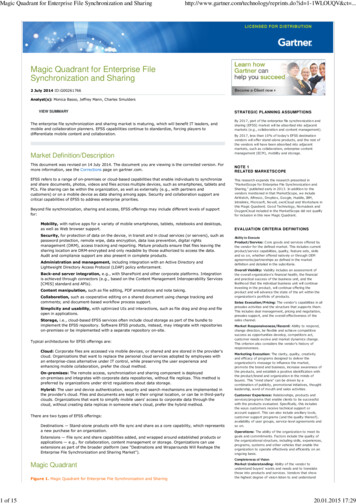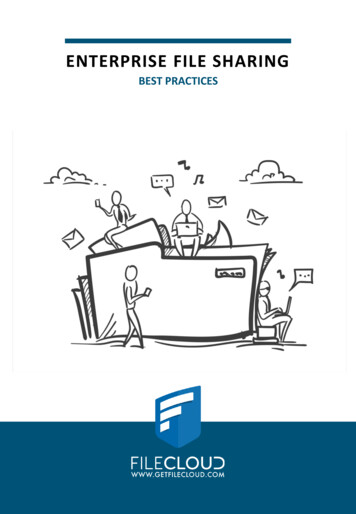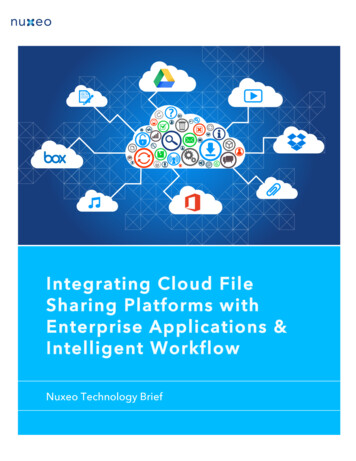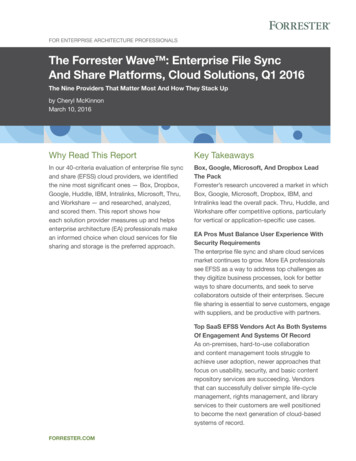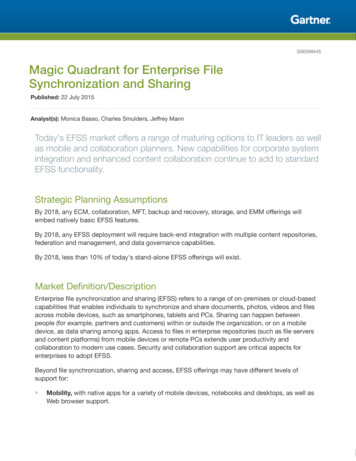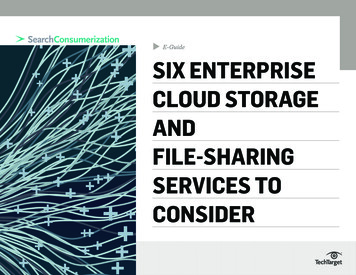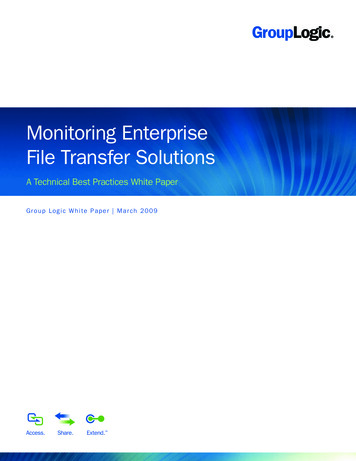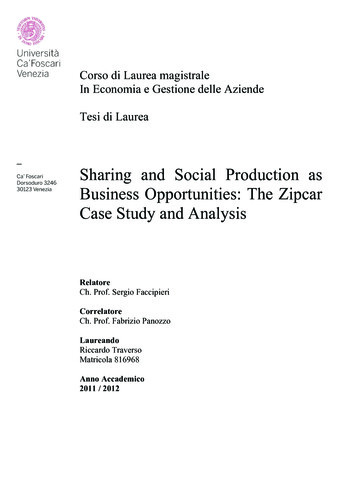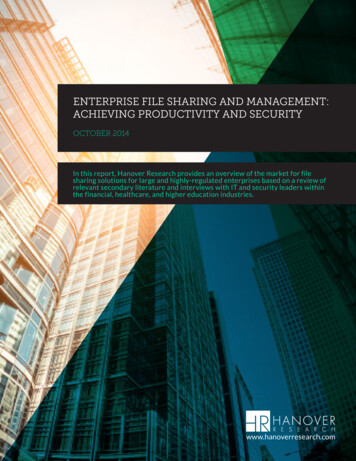
Transcription
ENTERPRISE FILE SHARING AND MANAGEMENT:ACHIEVING PRODUCTIVITY AND SECURITYOCTOBER 2014 In this report, Hanover Research provides an overview of the market for filesharing solutions for large and highly-regulated enterprises based on a review ofrelevant secondary literature and interviews with IT and security leaders withinthe financial, healthcare, and higher education industries.www.hanoverresearch.com
Hanover Research October 2014Enterprise File Sharing and Management: Achieving Productivity and SecurityTABLE OF CONTENTSEXECUTIVE SUMMARY 3INTRODUCTION 3KEY FINDINGS 3RECOMMENDATIONS 4SECTION I: MARKET LANDSCAPE5OVERVIEW 5SOLUTIONS 6SECTION II: FILE SHARING SOLUTIONS FOR REGULATED ENTERPRISES7OVERVIEW 7SECURITY AND COMPLIANCE 9HEALTHCARE 9FINANCIAL SERVICES 11HIGHER EDUCATION 11RISK MITIGATION 13OTHER FACTORS 14TRENDS 15MOBILITY 15INTEGRATION 18APPENDIX A: PARTICIPANT INTERVIEWSAPPENDIX B: ABOUT THIS REPORTREPORT SPONSORS 2020ABOUT HANOVER rch.com202
Hanover Research October 2014Enterprise File Sharing and Management: Achieving Productivity and SecurityEXECUTIVE SUMMARYINTRODUCTIONIn this report, Hanover provides an overview of the file sharing practices and perspectives of large and highlyregulated enterprises. Section I of the report summarizes the overall market, while Section II presents an analysisof highly-regulated industries’ requirements for electronic file sharing solutions based on original interviewsconducted with knowledgeable industry sources. A summary profile of these respondent experts is provided inAppendix A.KEY FINDINGS Highly-regulated enterprises and companies that manage a large volume of sensitive personal or financialinformation view data security and risk mitigation as a non-negotiable prerequisite for any electronic filesharing solutions. While other considerations may influence vendor selection, these are secondary to theoverriding necessity for top-tier security. Mobility is an increasingly significant driver of corporate interest in file sharing solutions. However,security concerns with public cloud services are leading compliance-focused enterprises to delayimplementation and/or limit use of these services. The inability to access files via mobile platformsis a visible pain-point for large and highly-regulated companies, but the need to protect sensitive datafrequently poses a prohibitive obstacle. The ability to integrate file sharing solutions with other enterprise software and programs is a relativelylow priority for enterprise customers. It is not uncommon for different groups within a single largeorganization to have separate, non-integrated file sharing solutions. While there is clear interest in unified,integrated systems, the level of effort required to accomplish this goal is seen as prohibitively high, whileongoing frustration with the current state of limited integration – while real – does not rise to the level ofbeing a determinative factor in decisions regarding file management. In implementing file sharing and management solutions, highly-regulated enterprises seek to avoid risks– including security lapses, illicit access, exposed files, and service outages – commonly associated withemployee use of public cloud solutions. Regulated industries show a strong preference for on-site deployment of synchronization and sharingservices. This is principally driven by security concerns; until those concerns are addressed, theseindustries are unlikely to make the switch to hosted file sharing and management. The typical industryperspective is articulated by one senior IT source as “if we keep it in-house, we know we’re limiting ourrisks. I know that there are ways of mitigating the risks associated with hosted solutions, but would yourather mitigate those risks or just avoid them?”www.hanoverresearch.com info@hanoverresearch.com3
Hanover Research October 2014Enterprise File Sharing and Management: Achieving Productivity and SecurityRECOMMENDATIONS The World is Moving – For enterprises of every type and size, the evolution of work processes nowdemands capabilities that challenge traditional, IT-sanctioned file sharing methods. If employees lack access to a file storage platform with mobile file sharing capabilities, informationwill increasingly be transmitted via uncontrolled and potentially insecure channels. The increasing demand for knowledge sharing and productivity means enterprises withoutsecure and easy-to-use collaboration tools may either jeopardize data security or pay a penalty inoperational efficiency. Either outcome can put these enterprises at a competitive disadvantage. Compromise is Not an Option – IT leaders within large and highly-regulated enterprises are unanimousin stating that data security and regulatory compliance must be maintained to the highest possible degree. Top-tier data security should be considered table stakes for any enterprise in considering electronicfile management solutions. While other capabilities may factor into vendor selection, only offeringsthat provide the most robust security features should even enter into consideration. Regulatory compliance support is an essential element of any data management solution. Thelack of consistently up-to-date tools and systems ensuring ongoing adherence to evolving legalstandards creates risks that are otherwise unavoidable and should be considered unacceptable. Proceed with Caution but Proceed – Perhaps the greatest risk that an enterprise with outdated filesharing methods can take is doing nothing. Enterprise IT leaders must embrace their role as stewards ofcompany data, and also provide essential productivity, mobility and collaboration tools. Employees demand effective and user-friendly file sharing and collaborative capabilities, andorganizations that do not implement these internally will increasingly find sensitive data beingtransmitted via channels outside of their control – at a time when data thieves have reachedunprecedented levels of sophistication. By implementing mobile file sharing and collaboration platforms that leverage on-site deploymentmodels, enterprises can keep sensitive information under supervision without compromisingemployee productivity, operational efficiency, and competitive advantage.www.hanoverresearch.com info@hanoverresearch.com4
Hanover Research October 2014Enterprise File Sharing and Management: Achieving Productivity and SecuritySECTION I: MARKET LANDSCAPEOVERVIEWGlobal demand for enterprise file synchronization and sharing (EFSS) solutions is experiencing rapid growth,with projections suggesting that the market will reach 2.3 billion by 2018.1 In mid-2013, approximately 25percent of the global information workforce used consumer-grade file synchronization and sharing services – adramatic 400 percent increase in utilization since 2010.2File sharing and synchronization software has become an essential productivity-enabling resource forincreasingly mobile information workers. According to Forrester, about two-thirds of information workersshare files with others on a routine basis.3 However, in the absence of widespread enterprise EFSS solutions, amajority of information workers share documents and files via email and other unsecure methods.Figure 1.1: How Information Workers Share Documents85%Send them as email attachments or picture messages60%Put them on a network shared drive38%Put them on a USB flash drive or CD/DVD16%Put them in a file sync, sharing, or online locker service12%Keep them in a web-based office productivity site10%Use a service that my company providesRetrieve them from an online backup service4%Source: Shey, H.4IT security decision-makers are faced with a dilemma: how to provide employees with a functional file sharingsolution while minimizing the risk of data leakage.5 Though this matter carries particular urgency for largecompanies and companies in highly-regulated industries, roughly 60 percent of IT security decision-makersnote that they are concerned about consumer-oriented communications and file sharing tools running on noncorporate resources. However, while 88 percent of enterprises have security policies in place, only 41 percenthave both security policies and tools to enforce such policies.6“New IDC Worldwide File Synchronization and Sharing Forecast Shows Market Will Grow to 2.3 Billion by 2018” IDC, October 2014.http://www.idc.com/getdoc.jsp?containerId prUS2519261412Koplowitz, R., and Ted Schadler. “What File Sync And Share Customers Have Learned.” Forrester Research, July 24, 2013.3Shey, H. “Technology Spotlight: Enterprise File Sharing, Policies And Security.” Forrester, December 20, 2013.4Ibid.5Ibid.6Ibid.www.hanoverresearch.com info@hanoverresearch.com5
Hanover Research October 2014Enterprise File Sharing and Management: Achieving Productivity and SecuritySOLUTIONSWhile demand for secure EFSS solutions is higher than it has ever been, IT decision-makers face significantchallenges in vendor selection. Monica Basso of Gartner states that the market for electronic file sharingsolutions is “immature but crowded,” and market players present varied and difficult-to-assess claims regardingthe features of their EFSS offerings. Gartner notes that the emerging market for enterprise file synchronizationand file sharing focuses on six types of capability: (1) social and collaboration; (2) storage and backup; (3)content management, managed file transfer and collaboration; (4) mobile devices; (5) cloud virtualization; and(6) enterprise mobility. While all of these areas are receiving significant promotion, however, very few vendorsactually operate across these different sectors.There are more than 120 vendors active in the EFSS market, with “nearly all of them [leveraging] the publiccloud for storing files on behalf of enterprise users.”7 While this deployment method may be acceptable fororganizations that are not working with particularly sensitive information, highly-regulated enterprises do nothave the luxury of trusting such unsecure solutions. This difference in the capabilities required by large or highlyregulated enterprises is illustrated by the success of Dropbox, considered a “Challenger” in Gartner’s EFSSMagic Quadrant report. Dropbox “has been so successful to date by being end user friendly and largely ignoringIT”8 – this indicates a clear discrepancy between general enterprise file sharing and synchronization solutions,and the caliber of EFSS solutions required by highly-regulated industries.Scearce, T. “The Public Cloud – Is it Safe for Enterprise Files?” Attachmate, July 31, 2014. ic-cloud-safe-enterprise-files/7Miller, R. “Dropbox Looks to Shed ‘Dropbox Problem’ Image.” TechCrunch, June 6, 2014. hed-dropbox-problem-image/8www.hanoverresearch.com info@hanoverresearch.com6
Hanover Research October 2014Enterprise File Sharing and Management: Achieving Productivity and SecuritySECTION II: FILE SHARING SOLUTIONS FOR REGULATED ENTERPRISESIn this section, Hanover summarizes the observed market dynamics for electronic file sharing solutions inhighly-regulated industries based on primary interviews with industry experts and a review of relevant industrypublications.OVERVIEWUnlike individual knowledge workers, or even small-to-medium businesses, larger and more regulatedenterprises have unique and critical requirements for file synchronization and sharing solutions. According toGartner, chief information officers (CIOs) are interested in implementing enterprise file synchronization andsharing solutions to “improve employee collaboration and mobile access to information assets.”9 However, ITsecurity decision-makers in highly-regulated industries place greater importance on security and risk mitigationthan on improving employee collaboration and mobile access.According to the Privacy Rights Clearinghouse, the total number of known data breaches increased by almost74 percent from 2008 to 2013. In the healthcare industry alone, breaches have risen by 24 percent.Figure 2.1: Number of Data Breaches, by THER200820092010201120122013*BSR Businesses (Retail/Merchant); BSO Businesses (Other); GOV Government and Military EDU Educational Institutions (All);MED Healthcare; BSF Businesses (Financial and Insurance Services)Source: Privacy Rights Clearinghouse9Ruth, G., and Alan Dayley. “EFSS Changes How Users Deliver Data Services.” Gartner, May 29, 2014.www.hanoverresearch.com info@hanoverresearch.com7
Hanover Research October 2014Enterprise File Sharing and Management: Achieving Productivity and SecurityThe heavily regulated financial services and insurance industry accounted for about 10 percent of total databreaches in 2013, while medical/healthcare breaches represented 44 percent. When retail and educationbreaches are considered, the total swells to 75 percent of all breaches in 2013, up from 63 percent in 2008.Figure 2.2: Number of Data Breaches, by Industry (in % BSR Businesses (Retail/Merchant); BSO Businesses (Other); GOV Government and Military EDU EducationalInstitutions (All); MED Healthcare; BSF Businesses (Financial and Insurance Services)Source: Privacy Rights ClearinghouseIn light of workers’ rapid adoption of file sharing, the rising number of data breaches in highly-regulated industriesunderscores the need for systems that can support efficient workflows without compromising data security.Given the nature of information commonly shared in these industries, IT policy prioritizes different requirementsto govern employees’ use of file sharing software. The healthcare, financial services, and insurance industries(among others) view data security and loss prevention as key requirements, while end user needs like mobilityand ease-of-use are given secondary consideration.Enterprise file sharing and synchronization “is a growing category of services and applications that provideDropbox-style functionality, while also addressing the security and manageability needs that go along withhandling personally identifiable information (PII).”10 Industry experts expect that EFSS adoption will increasein the future, due not only to the convenience advantage over older file sharing tools like email and FTP, butalso because of the ability to provide access, authorization, and audit controls. Particularly among securityconscious enterprises, “adoption will be contingent on vendors successfully convincing customers of thesecurity model.”11GRADE.“A MINORITY OF FSS TOOLS IN USE ARE TRULY ENTERPRISE”- Osterman ResearchHo, B. “Enterprise File Synching For Sharing Financial Information.” Credit Union Times, September 17, 2013. overresearch.com info@hanoverresearch.com8
Hanover Research October 2014Enterprise File Sharing and Management: Achieving Productivity and SecuritySECURITY AND COMPLIANCEEnterprise CIOs and CISOs are expected to protect vital information assets from internal and externalthreats; however, most file sync and share solutions do not meet the compliance and security requirementsof highly-regulated enterprises. According to Osterman Research, “[content] shared using most FSS toolsis normally not encrypted unless the user specifically chooses to do so and installs additional software toencrypt the content.”12 While smaller companies in certain industries may adopt public cloud file sharingservices, use of such services is uncommon in large, highly regulated industries. And, Gartner notes,“[security] and compliance requirements may slow down the adoption of cloud-based EFSS” because ofindustry and regulatory distrust of the cloud.13One key regulation that applies across industries is the Sarbanes-Oxley Act (SOX), which was implementedin 2002 “in order to hold chief executives and chief financial officers of public companies accountable forcertifications of their financial reports from their companies.”14 IT and security managers must also addressSOX requirements for information security, as the law includes a provision requiring CEOs and CFOs attestto their companies’ proper internal controls. “It’s the IT systems that keep the books If systems aren’tsecure, then internal controls are not going to be too good.”15HEALTHCAREThe healthcare and life sciences industry faces some of the most stringent information security regulations.Healthcare companies must mitigate risks of noncompliance with the Health Insurance Portability andAccountability Act (HIPAA) and the Health Information Technology for Economic and Clinical Health(HITECH) Act.“File Synchronization and Sharing Market Forecast, 2012-2017.” Osterman Research, May 2013. FSS-Market-Report.pdf1213“MarketScope for Enterprise File Synchronization and Sharing,” Op. cit.Sabett, R. “The real deal with Sarbanes-Oxley: Perspectives for the security manager.” TechTarget. rity-manager14Hurley, E. “Security and Sarbanes-Oxley.” SearchCIO, September 25, 2003. ty-and-Sarbanes-Oxley15www.hanoverresearch.com info@hanoverresearch.com9
Hanover Research October 2014Enterprise File Sharing and Management: Achieving Productivity and SecurityThe HIPAA Security Rule focuses on safeguarding electronic protected health information (EPHI), and appliesto covered healthcare providers, health plans, healthcare clearinghouses, and Medicare prescription drug cardsponsors.16 HIPAA is the “number one file transfer priority for those in the healthcare space.”17Figure 2.3: HIPAA ComponentsHIPAAHealth Insurance Portability and Accountability Act of 1996Title ITitle IIHealth CareAccess,Portability, andRenewabilityPreventingHealth CareFraud andAbuseMedicalLiabilityReformElectronic ationCode SetsTitle IVTax-RelatedHealthProvisionGroupHealth PlanRequirementsTitle VRevenueOffsetsSecurityPrivacyIdentifiersTitle III Security Standards: General Rules Administrative Safeguards Technical Safeguards Physical Safeguards Organizational Requirements Policies and Procedures and DocumentationRequirementsSource: National Institute of Science and Technology18HITECH focuses on promoting the adoption and meaningful use of health information technology, such aselectronic health records. The Omnibus Rule was put in place to implement the HITECH Act, and requires that“all entities that handle healthcare data adhere to strict security and privacy requirements.”19Scholl, M., et al. “An Introductory Resource Guide for Implementing the Health Insurance Portability and Accountability Act (HIPAA)Security Rule.” National Institute of Standards and Technology (NIST), October 2008. ev1/SP-800-66-Revision1.pdf16Allen, K. “Transferring Healthcare Files in the US? Here are the Terms You Should Know.” Ipswitch File Transfer, May 15, 2015. http://www.ipswitchft.com/blog/healthcare file transfer terms/1718“An Introductory Resource Guide for Implementing the Health Insurance Portability and Accountability Act (HIPAA) Security Rule,” Op. cit.[1] “WatchDox Secures Healthcare Data for Providers, Insurers and Their Partners.” WatchDox, September 23, 2013. nd-their-partners-2/; [2] “TransferringHealthcare Files in the US? Here are the Terms You Shoul
regulated enterprises is illustrated by the success of Dropbox, considered a “Challenger” in Gartner’s EFSS Magic Quadrant report. Dropbox “has been so successful to date by being end user friendly and largely ignoring IT”8 – this indicates a clear discrepancy between general enterprise file sharing and synchronization solutions,
